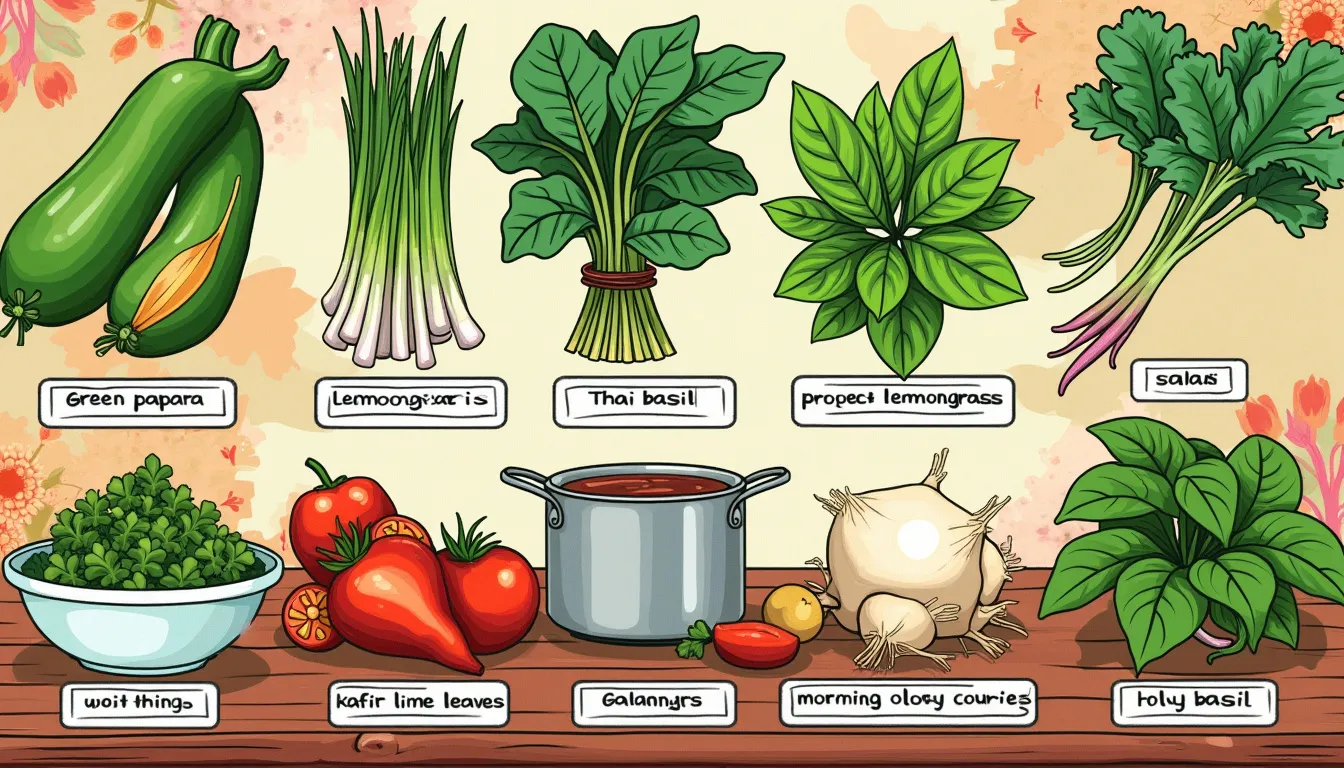Thailand’s culinary landscape is a vibrant tapestry woven with rich traditions, bold flavors, and an abundant array of fresh produce. At the heart of this dynamic cuisine lies a deep-rooted emphasis on vegetables, integral to countless Thai dishes that have captivated palates around the world. Thai vegetables are more than mere ingredients; they are the essence that brings authenticity and a unique depth of taste to traditional recipes. From markets buzzing with vivid greens and aromatic herbs to kitchens where these vegetables transform into delightful culinary masterpieces, understanding Thai vegetables opens a gateway to appreciating their significant role in Thai gastronomy. These vegetables not only enhance the flavors and textures of dishes but also reflect the changing seasons and cultural practices of Thailand. Delving into the world of Thai vegetables reveals the intriguing blend of health benefits and unparalleled flavors they offer, enriching both the culinary experience and nutritional value of the meals. By exploring the diverse types of Thai vegetables such as Thai basil, galangal, and kaffir lime leaves, one can truly appreciate the delicate balance they bring to the plate, making them indispensable to the authenticity and allure of Thai cuisine. Whether you are a culinary enthusiast eager to experiment with new ingredients or simply someone looking to savor traditional Thai flavors, uncovering the secrets of Thai vegetables could be your first step to a more enriched and flavorful culinary journey.
Introduction to Thai Vegetables
Overview of Thai Cuisine and Its Emphasis on Vegetables
Thai cuisine is renowned for its complex flavors, combining sweet, sour, salty, and spicy elements into harmonious dishes. Vegetables play a critical role in Thai cooking, offering freshness, nutrition, and unique textures that enhance the overall dining experience. Whether you’re indulging in a flavorful Thai green curry, a tangy som tam (green papaya salad), or savoring a delicate bowl of tom yum soup, you’ll find that Thai vegetables are indispensable components.
Importance of Thai Vegetables in Traditional Thai Dishes
In traditional Thai dishes, indigenous vegetables are not merely accompaniments; they are often the stars of the plate. Ingredients such as Thai eggplants, bamboo shoots, and water spinach provide essential flavors and textures that distinguish Thai cuisine from others. These vegetables are often combined with fresh herbs and spices, resulting in dishes with vibrant colors and robust tastes. The mastery of incorporating Thai vegetables manifests in the way they are cooked to maintain their natural goodness while drawing out their intrinsic flavors.
Seasonal Availability and Cultural Significance of Thai Vegetables
The availability of Thai vegetables often depends on the season, adding an element of anticipation and excitement to traditional cooking. For example, the rainy season is prime time for bamboo shoots, which are used in a variety of dishes such as gaeng nor mai (bamboo shoot curry). Conversely, the dry season brings an abundance of kabocha squash and winged beans, known for their unique shapes and textures.
Beyond their culinary uses, Thai vegetables carry immense cultural significance. They are frequently featured in traditional ceremonies and festivals, symbolizing prosperity, health, and longevity. Markets throughout Thailand bustle with vendors selling seasonal produce, providing locals and tourists alike with an immersive experience of the country’s rich agricultural heritage. The cultural integration of these vegetables also highlights Thailand’s sustainable agricultural practices and deep respect for nature.

Popular Thai Vegetables and Their Culinary Uses
Detailed List of Common Thai Vegetables
Thai cuisine is renowned for its extensive use of a wide range of vibrant and flavorful vegetables. Here’s a closer look at some of the most common Thai vegetables that are staples in many traditional dishes:
- Thai Basil
- Galangal
- Kaffir Lime Leaves
- Thai Eggplant
- Morning Glory
Thai basil, known for its sweet and slightly spicy flavor, is a versatile herb used in numerous Thai dishes. Unlike sweet basil, its leaves are smaller and more pointed, offering a unique aroma and taste.
Galangal, often mistaken for ginger, has a pungent and peppery flavor. Its fibrous texture makes it perfect for infusing broths and curries with a rich, earthy taste.
Kaffir lime leaves are integral for adding a fragrant citrusy aroma to Thai dishes. Their double-leaf structure makes them easy to identify, and they are commonly used in soups and curries.
Smaller and rounder than the conventional eggplant, Thai eggplant provides a mild, slightly bitter taste and is often used in green and red curries.
Also known as water spinach, morning glory has tender leaves and stalks that are typically stir-fried with garlic and chilies.
Nutritional Benefits and Unique Flavors of Each Vegetable
Each Thai vegetable not only brings a distinct flavor to the table but also offers various nutritional benefits:
- Thai Basil
- Galangal
- Kaffir Lime Leaves
- Thai Eggplant
- Morning Glory
Rich in vitamins A, C, and K, as well as essential minerals like calcium and magnesium, Thai basil is an antioxidant powerhouse. Its sweet, peppery notes make it a favorite in salads, stir-fries, and soups.
Galangal is known for its anti-inflammatory properties and aids digestion. Often used in traditional remedies, it gives a spicy, pungent kick that enhances the flavors of soups and stews.
Kaffir lime leaves are packed with antioxidants and essential oils that support the immune system. Their citrusy profile adds a refreshing twist to myriad Thai recipes.
Thai eggplants are low in calories but high in fiber, making them excellent for digestive health. Their subtle bitterness adds depth to curries and stir-fries.
A good source of vitamins A and C as well as iron, morning glory is known for its detoxifying properties. It adds a delightful crunch and mild flavor to stir-fried dishes.
Typical Thai Recipes and Cooking Methods Featuring Thai Vegetables
Thai cuisine incorporates these vegetables in a variety of traditional recipes, each with its unique cooking method:
- Thai Green Curry
- Tom Yum Soup
- Pad Krapow (Thai Basil Stir-Fry)
- Som Tam (Green Papaya Salad)
- Stir-Fried Morning Glory
Featuring Thai eggplants, kaffir lime leaves, and fresh basil, green curry is a staple in Thai households. The vegetables are simmered in a coconut milk base, creating a creamy, aromatic dish.
This iconic hot and sour soup relies heavily on galangal, kaffir lime leaves, and various vegetables to deliver its distinctive taste. These ingredients are boiled to extract their flavors into the broth.
Pad Krapow uses a generous amount of Thai basil sautéed with garlic, chilies, and protein of choice. The quick stir-fry method retains the fresh flavor of the basil and leaves a fragrant aroma.
This spicy, tangy salad often includes Thai eggplant and basil. The vegetables are shredded or chopped and mixed with a dressing made from lime juice, fish sauce, and chilies.
Morning glory is typically stir-fried with garlic, oyster sauce, and chilies, making for a quick and nutritious side dish that complements a variety of main courses.
Exploring the rich world of Thai vegetables allows you to appreciate not only their unique flavors and textures but also their significant contributions to the health benefits and culinary brilliance of Thai cuisine.
In conclusion, Thai vegetables are not just essential components of Thai cuisine; they are vibrant symbols of the country’s rich culinary heritage. From the distinct aromatic properties of Thai basil and kaffir lime leaves to the zesty spice of galangal, each vegetable contributes its unique flavor and nutritional benefits to traditional Thai dishes. These vegetables, intertwined with Thailand’s seasonal rhythms and cultural practices, elevate the cuisine to a sophisticated art form. By incorporating these ingredients into typical Thai recipes through various cooking methods, such as stir-frying, steaming, and currying, one can truly appreciate the full spectrum of tastes and textures that define Thai gastronomy. Exploring Thai vegetables allows us to not only savor their delightful flavors but also to gain a deeper understanding of the cultural and nutritional richness they bring to the table. So, whether you’re a seasoned cook or a culinary adventurer, diving into the flavorful world of Thai vegetables promises a rewarding and enlightening experience.







